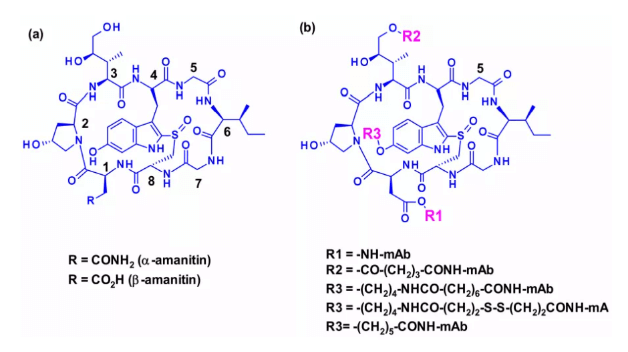Toxins/Payloads (Classification and function) of Innovative drugs
Apoptosis inducer (BCL XL inhibitor)
Overexpression of anti apoptotic Bcl-2 family members (including BCL XL) is one of the mechanisms for cancer cells to obtain apoptosis resistance. Drugs that block the BH3 binding domain on BCL XL can trigger cancer cell apoptosis.
Telanstadine and its analogues
Targeted spliceosome is a large ribonucleoprotein complex involved in mRNA processing, which provides a promising treatment option for targeted cancer therapy. Several natural products can inhibit RNA splicing by binding to different splice subunits. The most representative is thailanstatin A, which can bind to the SF3B subunit of spliceosome to prevent RNA splicing.

Amanita toxin
In the field of ADC technology, the use of transcription inhibitors similar to Amatoxins is a relatively new method. Nine naturally occurring amatoxin derivatives have the same skeleton structure. A macrocycle composed of eight L-configuration amino acids is partially connected between tryptophan and cysteine residues by sulfoxide. The three side chains of Amatoxins are hydroxylated, and the OH group has good water solubility and binds to the target molecule. Two peptides, α- Amanita glycoprotein and β- Amanita toxin accounts for 90% of all toxins.

Nicotinamide phosphoribosyltransferase
Nicotinamide phosphoribosyltransferase (Nampt) is an enzyme responsible for converting nicotinamide to nicotinamide mononucleotide. Its inhibitor has shown effectiveness in various preclinical and clinical studies, but its clinical application is limited by targeted toxicity and dose limiting toxicity, such as thrombocytopenia and gastrointestinal adverse reactions.
Camamycin
Two new protease inhibitors, camamycin A and camamycin B, were isolated from Curacao bacteria.







 View the Knowledge base of Antibody-drug Conjugate (ADC):
View the Knowledge base of Antibody-drug Conjugate (ADC):